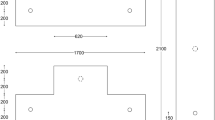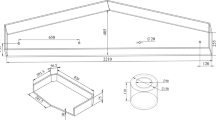Abstract
The inclusion behavior depends on the turbulent flow in the tundish. To make a deep understanding on the relation between flow field and inclusion behavior, the residence time distribution (RTD) curve is applied to analyze the flow field, the inclusion mass/population conservation model is applied to explore the inclusion behavior, and Pearson correlation is introduced to investigate the relation of RTD curve and the inclusion coalescence-removal. The numerical flow field and the number density confirm well with the measured data. Among plug volume fraction, well-mixed volume fraction and dead volume fraction, dead volume fraction is the most important factor to affect the inclusion removal rate and the dimensionless inclusion characteristic radius. For the same control devices in a tundish, structure parameters (distance from dam/baffle to tundish exit, the diameter of the hole in the baffle) can be optimized to obtained the maximum inclusion removal rate. Such a critical state can be expressed by the ratio of plug volume fraction to well-mixed volume fraction. But the dimensionless characteristic radius may be the maximum or the minimum at this critical state.















Similar content being viewed by others
References
M.J. Zhao, Y. Wang, S.F. Yang, J.S. Li, W. Liu, and Z.Q. Song: J. Mater. Res. Technol., 2021, vol. 13, pp. 561–72.
M.J. Zhao, Y. Wang, S.F. Yang, M.L. Ye, J.S. Li, and Y.H. Liu: Metals, 2021, vol. 11, p. 722.
H. Zhang, H. Lei, C.Y. Ding, S.F. Chen, H. Niu, and B. Yang: Steel Res. Int., 2022, vol. 93, p. 2200181.
B. Yang, K. Liu, H. Lei, and P. Han: High Temp. Mater. Process., 2022, vol. 41, pp. 460–68.
S. Chang, Z.S. Zou, J.H. Liu, M. Isac, X.K.E. Cao, X.F. Su, and R.I.L. Guthrie: Powder Technol., 2021, vol. 387, pp. 125–35.
S. Chang, W.X. Huang, Z.S. Zou, B.K. Li, and R.I.L. Guthrie: Powder Technol., 2020, vol. 367, pp. 296–304.
C. Yao, M. Wang, H.H. Zhu, L.D. Xing, and Y.P. Bao: Metall. Mater. Trans. B, 2023, vol. 54B, pp. 1144–58.
J.H. Wang, Q. Fang, L. Huang, P. Zhao, X.Q. Xie, and H. Zhang: Metall. Mater. Trans. B, 2023, vol. 54B, pp. 635–49.
Y. Sahai and R.J.I. Ahuja: Ironmak. Steelmak., 1986, vol. 13, pp. 241–47.
Y. Sahai and T. Emi: ISIJ Int., 1996, vol. 36, pp. 667–72.
Q. Wang, Y. Liu, A. Huang, W. Yan, H.Z. Gu, and G.Q. Li: Metall. Mater. Trans. B, 2020, vol. 51B, pp. 276–92.
W.X. Huang, S. Chang, Z.S. Zou, L. Shao, Y.X. Qu, and B.K. Li: Steel Res. Int., 2021, vol. 92, p. 2100012.
S. Chang, L.C. Zhong, and Z.S. Zou: ISIJ Int., 2015, vol. 55, pp. 837–44.
Q. Wang, Y. Liu, A. Huang, W. Yan, H.Z. Gu, and G.Q. Li: Powder Technol., 2020, vol. 367, pp. 358–75.
Q. Fang, H. Zhang, R.H. Luo, C. Liu, Y. Wang, and H.W. Ni: J. Mater. Res. Technol., 2020, vol. 9, pp. 347–63.
H.T. Ling, L.F. Zhang, and H.J. Wang: Metall. Res. Technol., 2017, vol. 114, p. 516.
M. Tkadleckova, J. Walek, K. Michalek, and T. Huczala: Metals, 2020, vol. 10, p. 849.
D.Y. Sheng and Z.S. Zou: Metals, 2021, vol. 11, p. 208.
C. Liu, A.D. Xiao, Z. He, W. Yan, G.Q. Li, and Q. Wang: Steel Res. Int., 2022, vol. 93, p. 2100818.
A.P. Zhang, M.M. Zhu, and J. Luo. Symposium on Materials Processing Fundamentals at Annual Meeting of The-Minerals-Metals-Materials-Society (TMS), Electronic network, March 14–18, 2021. pp. 31–41.
J. Luo, S.K. Peng, A.P. Zhang, and Y. Zhong. Symposium on Materials Processing Fundamentals at Annual Meeting of The-Minerals-Metals-Materials-Society (TMS), Electronic network, March 14–18, 2021. pp. 3–12.
M.R.M. Yazdi, A.R.F. Khorasani, and S. Talebi: Can. Metall. Q., 2019, vol. 58, pp. 379–88.
B. Yang, H. Lei, Q. Bi, Y.Y. Xiao, and Y. Zhao: JOM, 2018, vol. 70, pp. 2950–57.
H. Lei, L.Z. Wang, Z.N. Wu, and J.F. Fan: ISIJ Int., 2002, vol. 42, pp. 717–25.
D.Q. Geng, J.X. Zheng, K. Wang, P. Wang, R.Q. Liang, H.T. Liu, H. Lei, and J.C. He: Metall. Mater. Trans. B, 2015, vol. 46B, pp. 1484–93.
L.F. Zhang, J. Aoki, and B.G. Thomas: Metall. Mater. Trans. B, 2006, vol. 37B, pp. 361–79.
H. Lei: Metall. Mater. Trans. B, 2015, vol. 46B, pp. 2408–13.
C.Y. Ding, H. Lei, S.F. Chen, H. Zhang, Y. Zhao, and Z.S. Zou: Steel Res. Int., 2022, vol. 93, p. 2200187.
H. Lei, B. Yang, Q. Bi, Y.Y. Xiao, S.F. Chen, and C.Y. Ding: ISIJ Int., 2019, vol. 59, pp. 1811–19.
L.F. Zhang, S. Taniguchi, and K.K. Cai: Metall. Mater. Trans. B, 2000, vol. 31B, pp. 253–66.
D.Q. Geng, H. Lei, and J.C. He: ISIJ Int., 2010, vol. 50, pp. 1597–605.
M.Y. Zhu, S.G. Zheng, Z.Z. Huang, and W.P. Gu: Steel Res. Int., 2005, vol. 76, pp. 718–22.
C.Y. Ding, H. Lei, H. Zhang, M. Xu, Y. Zhao, and Q. Li: J. Mater. Res. Technol., 2023, vol. 23, pp. 5400–12.
H. Lei, D.Q. Geng, and J.C. He: ISIJ Int., 2009, vol. 49, pp. 1575–82.
T. Mizoguchi, Y. Ueshima, M. Sugiyama, and K. Mizukami: ISIJ Int., 2013, vol. 53, pp. 639–47.
C.Y. Ding, H. Lei, H. Niu, H. Zhang, B. Yang, and Y. Zhao: Metals, 2021, vol. 11, p. 430.
C.Y. Ding, H. Lei, H. Niu, H. Zhang, B. Yang, and Q. Li: Metall. Mater. Trans. B, 2021, vol. 52B, pp. 3788–804.
H.T. Ling, L.F. Zhang, and H. Li: Metall. Mater. Trans. B, 2016, vol. 47B, pp. 2991–3012.
S.C. Chelgani, S.S. Matin, and S. Makaremi: Measurement, 2016, vol. 94, pp. 416–22.
S.S. Matin, L. Farahzadi, S. Makaremi, S.C. Chelgani, and G. Sattari: Appl. Soft Comput., 2018, vol. 70, pp. 980–87.
M. Jafari, M. Golzadeh, S.Z. Shafaei, H. Abdollahi, M. Gharabaghi, and S.C. Chelgani: Processes, 2019, vol. 7, p. 653.
Acknowledgments
The research is supported by the Fundamental Research Funds for the Central Universities (N2109003).
Author information
Authors and Affiliations
Corresponding author
Ethics declarations
Competing Interest
The authors declare that they have no known competing financial interests or personal relationships that could have appeared to influence the work reported in this paper.
Additional information
Publisher's Note
Springer Nature remains neutral with regard to jurisdictional claims in published maps and institutional affiliations.
Rights and permissions
Springer Nature or its licensor (e.g. a society or other partner) holds exclusive rights to this article under a publishing agreement with the author(s) or other rightsholder(s); author self-archiving of the accepted manuscript version of this article is solely governed by the terms of such publishing agreement and applicable law.
About this article
Cite this article
Ding, C., Lei, H., Zhang, H. et al. New Understanding on Relationship Between RTD Curve and Inclusion Behavior in the Tundish. Metall Mater Trans B (2024). https://doi.org/10.1007/s11663-024-03087-1
Received:
Accepted:
Published:
DOI: https://doi.org/10.1007/s11663-024-03087-1




